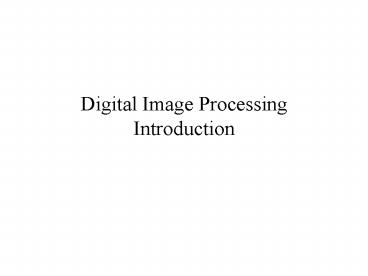Digital Image Processing Introduction - PowerPoint PPT Presentation
Title:
Digital Image Processing Introduction
Description:
Laser scanners: 3-D images. Radars. Magnetometers. Gravity meters. 9/8/09. 8 ... CT scanners. 9/8/09. 21. Image Encoding and Compression ... – PowerPoint PPT presentation
Number of Views:612
Avg rating:3.0/5.0
Title: Digital Image Processing Introduction
1
Digital Image ProcessingIntroduction
2
Course Info
- Course Outline
- http//cs.gmu.edu/asood/cs686/cs686-sood-a.html
- Course website
- http//cs.gmu.edu/asood/cs686
3
Overall Motivation 1
- Improvement of pictorial information for human
interpretation - Improve digitized newspaper pictures
- Circa 1920 5 gray levels 1929 15 levels
- 1960s correct for distortions introduced by
on-board cameras - Modern X-rays, pollution, pattern recognition,
art work, micro-arrays, sharing of images
(collaboration) - Panoramic views
4
Overall Motivation 2
- Processing of scene data for autonomous machine
perception (Machine Visual Perception) - Automatic Character Recognition
- Courtesy Amount Reading in checks what error
rate is acceptable? - Industrial robots, screening of x-rays and blood
samples, crop assessment - Object Recognition, Planning and Communication
5
Overall Motivation 3
- Build systems that use imaging as an enabling
technology - Remote desk top
- Street location recognition
- Parking lot management
- GIS
6
System Overview
Display Hard copy Transmission Remote
Processing Display
Storage
Image Capture (Acquisition)
Object/ scene
CPU
User Interaction
Image Sensor
A/D Conversion
Frame Processor
IP Workstation Zoom Scroll IP functions (MATLAB)
Storage Requirements Large Processing Real time
60 frames per sec/ On-line/Off-line
Enhancements -Parallel -Pipeline
7
Sensors
- What is measured?
- Visual intensity Luminance of object in the
scene - Thermal temperature infra red
- Xrays absorption characteristics
- Ultrasonic scanning
- Laser scanners 3-D images
- Radars
- Magnetometers
- Gravity meters
8
Assessing Sensor Quality
- Resolution
- Uniformity of grid
- 2-D or 3-D images
- Indirect measurement
- Noise effects
9
Applications
- Active vs Passive
- Remote sensing via satellite
- Agriculture monitoring
- Land use
- Weather
- Flood and fire control
- Defense intelligence
- Environment monitoring
10
Business / industry
- Scanning
- Re-use
- Multiple locations
- Security
- Fax
- Robots
- Industry, defense, consumer, environment
- Medical
- Patient screening and monitoring, treatment
planning
11
Overall tasks of IP CV
- Object Recognition
- Planning
- Communications
- Unmanned vehicles / intelligent robotics
- Perception, planning and action cycle
Architecture
Sensors
Algorithms
12
IP Problems
- Image Representation and Modeling
- Image Enhancement
- Image Restoration
- Image Analysis
- Image Reconstruction
- Image Compression
13
Image Representation and Modeling
- Fidelity or intelligibility criteria
- Design and evaluation of imaging sensor
- Sampling of a BW TV signal
- Models of perception
- Contrast, color, spatial frequencies
- Sampling rate, quantization levels and errors
- Represent images as a combination of basic images
- Characterization of local behaviors
14
Image Representation and Modelling
- Perception Models
- Fidelity
- Temporal perception
- Scene perception
- Local models
- Image quantization
- Deterministic (transforms)
- Statistical (time series)
- Global
- AI / Scene analysis
- Sequential and clustering
- Image understanding
15
Fidelity of Image Sampling
- How to assess fidelity? Often based on quality
measures. - Reconstruction image from sampled image.
- Black and white TV signal has about 4 MHz
bandwidth. What rate should it be sampled? - Sampling rate (Nyquist) gt 8,000,000 per sec
- Frames samples in 1/30 sec
- Samples per frame 8000000/30 266,000
- No of lines per frame 525
- No of samples per line 266,000/525500
- If 512 lines per frame, then 512 samples / line
16
Image Enhancement
- Reduce noise
- Accentuate certain image features
- Techniques
- Contrast enhancement
- Edge enhancement
- Noise filtering
- Sharpening
- Magnifying
- Methods are usually iterative and application
dependent - Picture of mars, X-ray
17
Image Restoration - 1
- Objective is to minimize or remove known
degradations in the image. - Sensor induced
- noise,
- geometric distortions
- non-linearities
- Camera calibration
- Given Image and Sensor Transfer Function estimate
the object
18
Image Restoration - 2
Transfer Function
Object f(a,b)
Sensor h(x,ya,b)
Image g(x,y)
Objective Given blurred image g(x,y),
PSFh(,,) and noise characteristics
Find f(a,b)
19
Enhancement Restoration
- Similar objective
- Enhancement more heuristic
- Restoration mathematical model driven
20
Image Reconstruction from Projections
- Projections to 3-D rendering
- CT scanners
21
Image Encoding and Compression
- Image potentially require large storage maybe
GBs - 1K x 1K x 12 bits/pixel requires 1.5MB
- Can we reduce the number of bits per pixel?
- Impact on quality
- Fidelity
- Lossless vs lossy
- Applications in telemedicine, videoconferencing,
22
Image Analysis
- Making quantitative measurements from images
- Input to the object recognition, planning tasks
- Often relies on segmentation
- Isolates objects
23
Image Segmentation
- Edge detection
- Region growing
- Occlusion, overlapping objects
- Scale and rotation































